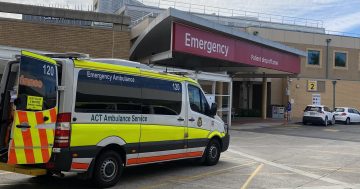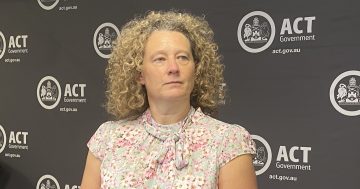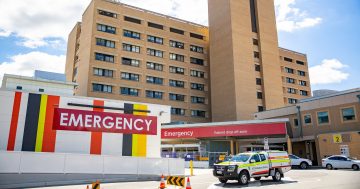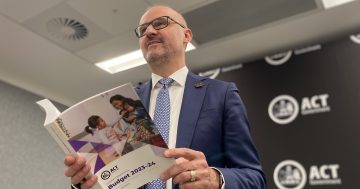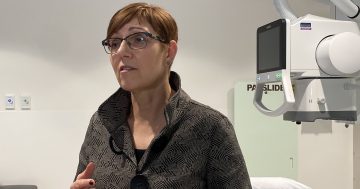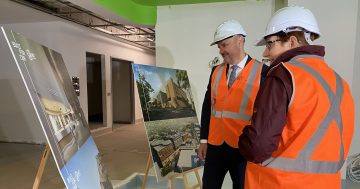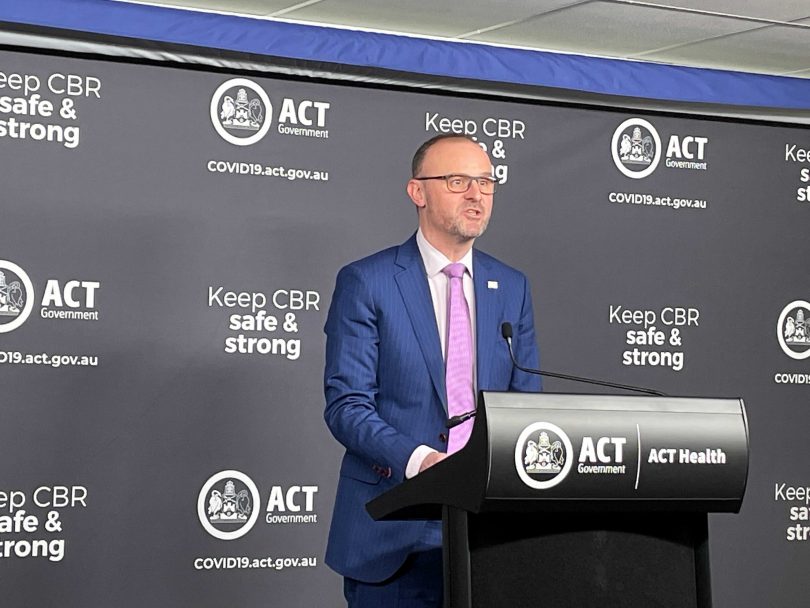
Chief Minister Andrew Barr said the ACT needed to be cognisant of national vaccination rates to reduce the spread of the virus. Photo: Dominic Giannini.
Chief Minister Andrew Barr said the ACT would wait until the nation eclipsed the 70 per cent fully vaccinated threshold before moving to ease local restrictions, despite the estimated three-week gap from when the Territory reaches the milestone and vaccine efficacy.
When questioned over why national vaccination rates should impact local restrictions, Mr Barr said the ACT needed to be cognisant of national vaccination rates to ensure people coming into the Territory had similar vaccination levels to reduce the spread of the virus.
“We are part of the nation. We are an island jurisdiction inside NSW without the capacity to have hard borders so we also need the population that is coming into the city to be vaccinated as well,” he said.
“We have the responsibilities in relation to our national capital status to ensure the smooth functioning of the Australian democracy.
“It is not just Parliamentarians, it is also all of their staff and Commonwealth bureaucrats who need to move all around the country. We [also] regularly have international delegations [and] ministers returning from overseas who need to quarantine.”
The decision to move to the next phase of lockdown once vaccination thresholds have been reached will also be based on local case numbers and the Territory’s ability to test, trace, isolate and quarantine new cases.
Health authorities are increasingly concerned about asymptomatic transmission from vaccinated Canberrans, with most of the people who have been infectious in the community not being aware they are carrying the virus.
Mr Barr said rapid antigen testing would form part of the solution to this problem late into spring and into summer as he acknowledged that there will be breakthrough infections among vaccinated people.
This was a contributing factor for not giving fully vaccinated people more freedom while the ACT’s vaccination rates lag behind the 70 and 80 per cent thresholds.
When asked whether the plateauing numbers and continual increase in vaccination meant the ACT would not be able to further reduce cases due to asymptomatic transmission, Deputy Chief Health Officer Dr Vanessa Johnston said the ACT would consider more than just daily cases when reviewing lockdown restrictions.
“Once we get to high levels of vaccination coverage, those trains of transmission will be interrupted so it will not have the same consequence,” Dr Johnston said.
“That is what the modelling tells us.”
Focus this week has been on the ACT’s roadmap out of the current lockdown after Mr Barr announced an extension to 15 October, along with some easing of restrictions.
In the lead up to yesterday’s (14 September) press conference, Mr Barr repeatedly said he did not want to pre-empt which restrictions would be eased, explaining that a more detailed plan would be unveiled on Tuesday.
Businesses and the Canberra Liberals expressed disappointment in the plan, criticising it for being too vague and not attaching any concrete easing of restrictions to vaccination targets.
The plan said that the ACT would be in “a positive position” to ease restrictions locally once the nation and the Territory reached the thresholds.
When asked whether the announcement was billed as a more concrete plan only to disappoint compared to NSW attaching more than a dozen “freedoms” to the 70 per cent threshold, Mr Barr said the plan had been miscategorised.
“It was the media that categorised it as a roadmap. We said it was a pathway forward [to] outline our next steps,” he said. “It is challenging to communicate this level of information and detail this far out from making decisions.
“NSW has put something out there, and I do not criticise them for having a go, but what I will not stand for is that [the NSW plan] is characterised as some concrete roadmap that outlines every step because it does not.
“NSW has put in place a range of measures that are a month away with heavily caveated local circumstances and variances within their own state. It is not a detailed roadmap for the future; it is a guess about what could happen in four weeks time.”
Mr Barr said any movement away from the current restrictions would be flagged around a week ahead.
The next steps include increased home visitation numbers, larger gatherings, increased business density limits and a phased return to the office and face to face schooling.
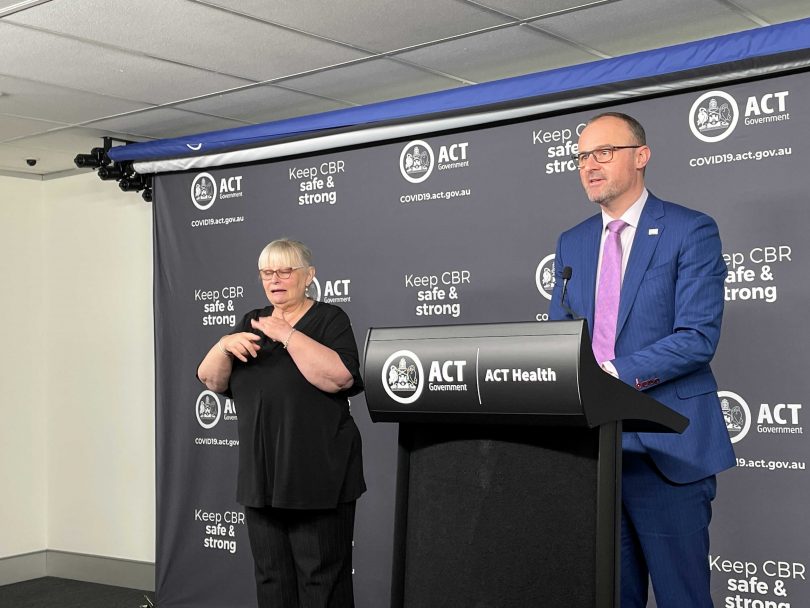
Chief Minister Andrew Barr at this morning’s COVID-19 briefing. Photo: Dominic Giannini.
UPDATED 12:30 pm: The ACT has recorded 13 new cases of COVID-19 overnight.
Eight are close household contacts; eight spent part of their infectious period in the community.
And as seven new COVID diagnoses have been recorded today in surrounding southern NSW, Chief Minister Andrew Barr noted at today’s press briefing that cases are “lighting up everywhere” across the ACT’s borders, with likely implications for Canberra’s tertiary health care capacity as the year goes on.
“This is one of the toughest moments in our city’s history,” Mr Barr said.
“I want people to know it is OK to reach out and ask for help if you need it. There will be better times ahead for Canberra. Our vaccination milestones are in sight. We need to work towards a safer Christmas for everyone.”
Deputy Chief Medical Officer Dr Vanessa Johnston said that there are still 50 unknown cases in the ACT.
“This means there are cases that we are not aware of,” she said.
“If we were to relax restrictions now, we risk this outbreak escalating at a time when not enough of us are vaccinated. There would be a proportion of people with severe disease outcomes including hospitalisation, intensive care and death,” Dr Johnston said.
Yesterday, 3311 tests were conducted, giving good surveillance of the disease. Around 4000 vaccine doses were administered in ACT Government clinics, 39 per cent of which were second doses.
In the ACT, 75 per cent of people in the 12-plus population have now received their first doses.
However, 70,000 people are still waiting on their first dose at ACT Government clinics.
Mr Barr said the balance of the vaccination program will now begin shifting to second doses and will pick up speed significantly. The government anticipates that when the 70 and 80 per cent milestones are reached, the vaccination program will put the city in a strong position to return to COVID-normal life as soon as possible.
“While COVID continues to circulate in our community and across the border and we are increasing our vaccination coverage, restrictions need to remain in place,” Mr Barr said.
But the ACT is not anticipating that Canberrans will need proof of vaccination to access public and private services.
When looking to changes to public health measures, Mr Barr said the government would consider local and national vaccination rates, community transmission and especially the proportion of people who are infectious in the community, testing times, the ability to test trace isolate and quarantine, how well business is complying, data on the effective reproduction rate and transmission potential within the community.
At this point, restrictions will ease as they did last year, including home visitation numbers, gathering sizes and density limits on businesses. Limits are likely to continue in high-risk venues, including residential aged care, hospitals and jails, and it’s likely that return to work will be gradual.
Mr Barr said each phase would be advised in advance.
“Right now, we need to give more than 100,000 Canberrans the opportunity to get vaccinated in the next four weeks as we suppress our current outbreak,” he said.
The government continues to work with the Commonwealth on business support and there is no need to reapply for increased grants. The Commonwealth has indicated likely further increases to business support grants at the two-week checkpoint on 1 October.
Larger ACT businesses will be able to access top-up payments and there will be additional support for local businesses that have been particularly hard hit, including tourism, arts, events and hospitality, all of which sustained a tough few months ahead of the local lockdown.
There are now 290 active public exposure locations, including some areas of the ACT Magistrates Court. No new cases have been linked to existing sites.
Dr Johnston asked anyone with symptoms to be tested immediately and go home immediately while awaiting results.
“We are still seeing people who are infectious and attending essential work,” she said. “This is why social restrictions are so important while we are working towards our vaccination goals.
“We know lockdown is hard, but if we continue to do the right thing and stay the course, we will be in a stronger position in the weeks to come.”
UPDATED 11:55 am: The ACT has announced 13 new cases of COVID-19 in the past 24 hours.
Eight are linked to close household contacts and five remain under investigation.
Five were in quarantine for the entirety of their infectious period and eight spent part of their infectious period in the community.
Seven people are currently in hospital with COVID and one is in ICU requiring ventilation.
Yesterday the ACT recorded 22 new cases.
Over 4000 vaccine doses were administered in ACT Government clinics yesterday: 61 per cent received first doses and 39 per cent received second doses.
Currently, around 75 per cent of people aged 12 and over have been given at least one dose of a vaccine.
Around 70,000 people are waiting for a first dose in ACT Government facilities and tens of thousands more will receive their first dose from primary care providers.
In NSW, Premier Gladys Berejiklian announced 1259 new cases and 12 deaths. There are currently 1,241 cases in hospital, 234 people in ICU and 108 on ventilators.
NSW had also reached 80 per cent single-dose vaccination on Monday, with 47.5 per cent of adults double dosed.
There were 1127 cases and two deaths yesterday.
Victorian Premier Dan Andrews announced 423 new COVID cases and two deaths.
Around 67.7 per cent of eligible Victorians have received one dose of vaccine and 41.4 per cent have been fully vaccinated.
There were 445 new cases and two deaths yesterday.
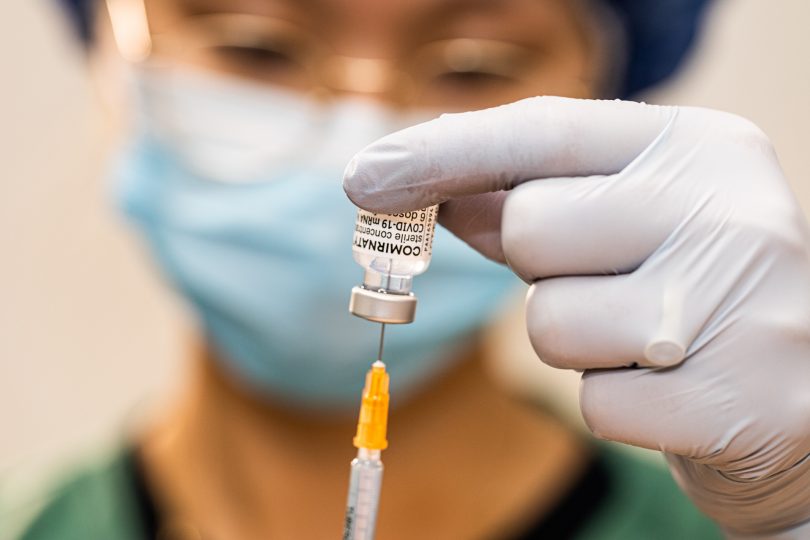
Staff at the AIS mass vaccination clinic had to dispose of 170 jabs after the clinic was overbooked. Photo: Michelle Kroll.
9:55 am: Health authorities were forced to throw out 170 syringes with drawn Pfizer doses on Monday (13 September) after the AIS mass vaccination clinic was overbooked and people had to be sent home.
Wait times hit two hours at around lunchtime and more staff were called to the clinic to clear the queue.
Health Minister Rachel Stephen-Smith said even with the extra staff, the team realised they would not meet the demand and people who had appointments from 6:30 pm were told not to come in.
But people were then called back when staff realised they had overdrawn 400 doses.
No official wastage was recorded for the day as health staff were able to extract seven doses from a Pfizer vial, which usually yields between five and six doses, counteracting the jabs that were thrown out.
Ms Stephen-Smith said the error occurred because the system took bookings based on the increased vaccine supply expected next week.
Chief Minister Andrew Barr, Ms Stephen-Smith and Chief Health Officer Dr Kerryn Coleman will update the ACT’s COVID-19 situation at 11:45 am after unveiling the Territory’s roadmap yesterday.
More to come.












